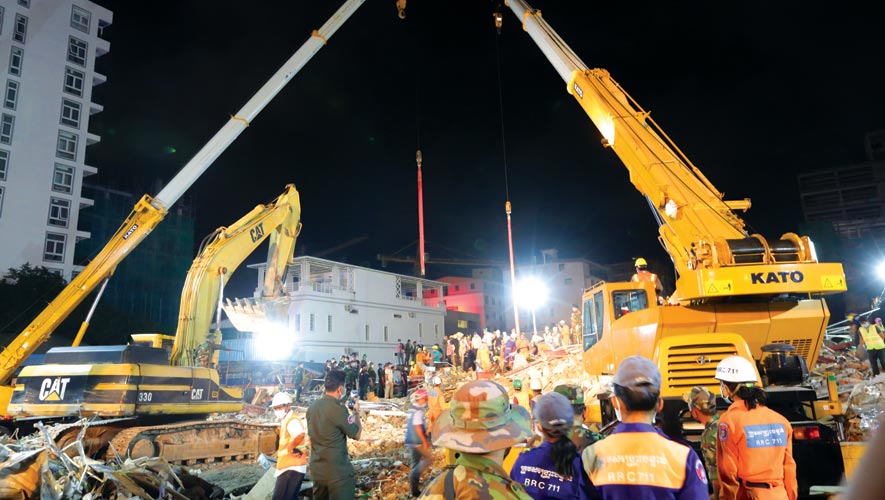The arrest of three Chinese nationals with $3.5m in their bag has only roused further suspicion over the state of illegal money making its way into the Kingdom. Questions remain unanswered if the situation is merely the tip of the iceberg
For the latest Cambodian Business news, visit Khmer Times Business
When three Chinese nationals sauntered into Phnom Penh International Airport’s arrival hall on April 23 with a suitcase of $100 bundles amounting to $3.52 million, shockwaves rippled through the Kingdom. It raised questions over airport checks, and their boldness. But more so, the blatant act of alleged money laundering.
It also elicited doubts whether there have been similar situations at border controls, if it is easy to smuggle in money, and does bribery played a part in enabling the entry of unaccounted cold hard cash into Cambodia.
“Money laundering allegedly happens easily in Cambodia, particularly at seaports, and land border checkpoints. The money is most likely used to finance real estate developments, given that the property sector is growing at a fast pace, land purchases and games at casinos,” according to Transparency International Cambodia executive director Preap Kol.
He says the authorities should be on alert at every level, particularly land border checkpoints and seaports, as money laundering activities at these zones have less sophisticated equipment unlike airports which make it easy for black money to enter Cambodia. It is also believed that private jet passengers, and possibly illegal money traffickers on late night flights slip under the radar.
But, he remains alarmed over the three suspects’ exit from Hong Kong, and into Cambodia with the cash despite the presence of security camera, scanning machines, clearance and custom checks. The trio have since been charged under Article 3 and 23 of the Law on Anti-Money Laundering Act and Combatting the Financing of Terrorism, and placed under pre-trial detention.
“If this can happen at the airport, can you imagine border checkpoints, which do not have sophisticated equipment, and little procedure to mitigate risk? To me, I feel it is due to a corrupt system. In fact, for every arrest of unaccounted money entry, there are probably 10 or more that go unnoticed,” Kol adds.
To top that, the banking system in Cambodia is allegedly not strong enough to detect the source of money. He says that alleged large sums of money that track into banks for the construction and real estate sectors do not match with the number of property developments in Cambodia, particularly the Sihanoukville province.
“I want to know where does the money come from? Somebody might have made a private investment but large sums of money like that most likely come from non-traceable sources,” Kol tells Capital Cambodia.
However, Acleda Bank Plc president In Channy, who is also chairman for the Association of Banks in Cambodia, denies any allegation of money laundering in the banking system. He stresses that the money laundering law ensures that banking activities occur above board.
“We monitor every money transfer. Cash-based transfers adhere to the KYC—Know Your Customer policy, which means money moving in and out of the country has a clear history and traceable sources,” Channy adds.
Last year, the Basel Anti-Money Laundering Index, an independent annual ranking that assesses the risk of money laundering and terrorist financing in the world, rated Cambodia as one of the highest risk countries in this area. It placed Cambodia seventh, with a score of 7.48 out of 10 (10 being highest), out of 129 countries surveyed for its level of risk.
In addition, Paris-based Financial Action Task Force (FATF) listed Cambodia as being highly vulnerable to money laundering in 2017. It identified deficiencies in Cambodia’s jurisdiction and strategic anti-money laundering and countering financing of terrorism. However, in February this year, it moved Cambodia out of the black list and into the grey list.
In 2016, the Kingdom’s first National Risk Assessment report acknowledged factors that might have enabled money laundering activities including its largely cash-based dollarised economy and widespread use of informal financial services, booming real estate sector, and large casino-based gambling sector.
It also noted that there has been no prosecution of money laundering cases, insinuating that there might be corruption present in the Cambodian judicial system.
“Our anti-money laundering law is weak and does not have a strong mechanism to enforce the law effectively. The Financial Intelligence Unit (FIU) is not tasked to investigate. It is only there for administrative purposes. So, although we have a law, no action can be taken,” Kol adds.
But, it should be noted that National Bank of Cambodia’s national strategy (2019-2023) under the anti-money laundering law was drawn up to strengthen the legislation through prioritised and timely action points.
It requires every jurisdiction to immediately detect illegal activities, freeze and confiscate the proceeds and instruments of the offence.
International Monetary Fund resident regional advisor for the legal department for anti-money laundering Clive Scott says the national strategy would be able to get Cambodia out of the grey list altogether and into the white list.
“Being in the grey list can affect investment decisions and banking relationships but if Cambodia can implement the strategy effectively, there should be no reason why the country shouldn’t exit the list,” Scott says.
However, Kol says that there should first be a genuine political will to do that. “Cambodia has to strengthen its collaboration (with other countries) to prevent transactional crime. It should work with countries which it shares borders with, and beef up border checks,” he adds.




